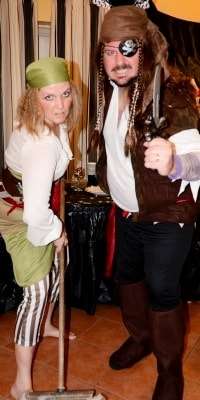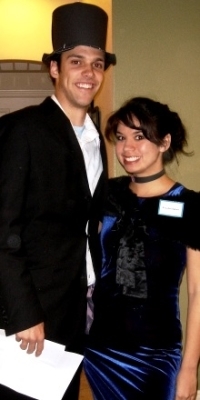How to write an extra character for your murder mystery game
Sometimes, you have more guests coming to your murder mystery party than you originally envisaged. Rather than have them watch, you could instead write an extra character for them. This is how we do it.
How to write an extra character
All of our games come with at least one extra character. (You can see the full list here.) But if that’s not enough, or you have your own idea, then you will have to write a character of your own.
You can use our template to create characters in the right format so they don’t stand out from the “real” characters.
You can also send your characters to us (see how to do this at the end of this article). If we like them and publish them on our website, we will thank you with a free game of your choice.
But how to write an extra character for your murder mystery game? That’s what this article is for.
Murder at the Ball
For this article, we will create a couple of imaginary optional characters for an imaginary murder mystery party: Murder at the Ball.
Murder at the Ball is a murder mystery set in the world of fairytales. Characters include Prince Charming, Cinderella, Snow White, the Wicked Witch, Sleeping Beauty, Beauty and the Beast, and other familiar characters. The setting is the grand ball, where all the plots will unfold.

Two extra characters
We’ve realised that we need two extra characters as we have two more guests coming than originally expected.
Here are some typical extra characters we find easy to add:
- Assistants, deputies, underlings
- Rivals and enemies
- Family – close relatives (sons, daughters, husbands, wives, brothers and sisters)
- Characters linked to plots that involve lots of people
- Investigator-types – reporters, extra detectives
- Spies or diplomats
First, decide what additional characters to add.
Having read through the game, we’ve decided to add Fairy Tulip, an assistant to the Fairy Godmother, and Jack the Giant Killer (from Jack and the Beanstalk).
We’ve chosen these because the Fairy Godmother already has plenty to do, and Murder at the Ball has a plot all about electing a new mayor, which involves a lot of people, and we can fit Jack into.
Background
We usually start our character backgrounds with a summary of who the character is and why they are present in the game:
“You are Fairy Tulip, and you are here to help the Fairy Godmother.”
“You are Jack the Giant Killer, and you are here because you want to become mayor.”
Then we explain any background information that the characters know (including links to other plots), along with what they need to achieve.
So for Fairy Tulip, this would include some things that the Fairy Godmother is working on that she can help with. We would refer to the Fairy Godmother’s character sheet for examples – but we wouldn’t copy it word for word, but instead write it from Fairy Tulip’s perspective.
For Jack, we would look at other mayoral candidates and use their descriptions of how the election works in Jack’s background.
Do the same with other plots. For example, we would normally tie them into the murder plot. For example, maybe Fairy Tulip was a close friend of the victim and is motivated to find the murderer. With Jack, we might decide that some clues pointing to the murderer also point to Jack – turning him into a suspect.
Where possible, we try to include conflict in our plots. So, Fairy Tulip might not agree with all of the Fairy Godmother’s plans and might want to foil one or two. Similarly, Jack could be a rival to one of the other mayoral candidates.

Goals
A character’s goals remind and clarify the character’s objectives. They should add nothing new that isn’t already covered by the background.
The number of goals varies from game to game and character to character, but at least four goals is a good number to aim for.
Other People
We use the Other People section to add useful snippets of information about other characters that our new characters know (or know about).
We try not to repeat the information on the cast list. Instead, we add something that lets the player strike up a conversation, either with that person or someone else.
Our new characters should need no more than five or six Other People entries, so they won’t need an entry for everyone.
We find it useful to look at the Other People sections of the original characters. Often, those entries can be copied word for word as they often reflect things they have seen or have heard stories about – and our new characters might have seen those same things or heard those same stories.
Some examples:
- Prince Charming: You met Prince Charming earlier and he told you he was looking for a glass slipper.
- Snow White: You’ve heard a rumour that Snow White has been living in the forest with some dwarves.
Abilities
The easiest way to give abilities to our new characters is to copy abilities from other characters. If you’ve played one of our other games, you could also copy an ability from that game.
We normally give each character three abilities.
Secret and Clue
Most characters have a guilty secret they want no one else to know – that’s what goes in their Secret. This is ideally incriminating, although we don’t put the identity of the murderer in Secrets because we want the murder to be solved by using deduction rather than abilities!
A character’s Clue is a piece of information that the character knows. This relates to one of the plots, often the murder plot. We put key information here to ensure it circulates around the game (to those who need to know) via abilities.
Items and money
Our new characters may need items that are both needed for their backstory and help with other plots. For example, Fairy Tulip ought to have a wand, and Jack the Giant Killer might have magic beans, a golden harp and (perhaps) an axe.
Information for the original characters
Once we’ve finished our characters, we need to link them to the original characters. If we don’t, our new characters may struggle to interact with the original characters.
We first decide who needs to know these new characters. Where we have created an assistant or a family member then they will need to know who this new character is, but there will also be other characters who will know something about your new characters.
In our example, the Fairy Godmother will clearly need information to introduce Fairy Tulip, who may be known by other characters as well.
Where we’ve told one of our new characters they have interacted previously with an original character, then it is important to tell that character of the interaction. For example, we added to one of our characters that Prince Charming had told them he was looking for a glass slipper (see Other People, above). It’s worth telling Prince Charming that he has asked Jack the Giant Killer about the glass slipper, but that Jack didn’t know where it was.
When we give our characters guilty secrets, we make sure that another character either knows their secret already or has clues that they aren’t what they seem. For example, suppose we decide that Jack the Giant Killer is a fraud and didn’t actually climb the beanstalk and kill the giant. Here we might give Rapunzel some more information that she recognises that Jack is really Rumplestiltskin.

How to write an extra character
And that’s it! Easy!
Submit your own character and get a free game!
If you have written your own characters and would like us to include them here, please first download the template and use it to create your character.
Then, use our contact form to tell us about it. (If you’ve created other handouts or aids and would like us to share them, please send them as well.)
Please don’t send us anything that infringes on anybody else’s copyright property. For example, while Captain Jack Sparrow and Will Turner (from Disney’s Pirates of the Caribbean: Curse of the Black Pearl) might be obvious characters to add to A Dead Man’s Chest, I’m afraid we cannot use them.
Please note:
- Documents become the property (and copyright) of Freeform Games LLP, although we will credit you.
- We reserve the right to use the documents in future releases.
- We will edit the files to correct errors, to suit our style and formatting, and to remove any offensive content.
- We reserve the right not to post them on our website if we consider them unacceptable or for any other reason.
If we use your character on our website, we will offer you a free game!
